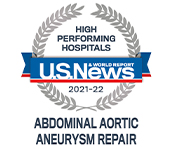Aortic Aneurysm
 If you have an aortic aneurysm, Mount Sinai's vascular surgeons can help. We have extensive experience diagnosing and treating the condition, using the most advanced minimally invasive procedures and traditional open surgery. We develop a personalized treatment plan tailored to your condition and lifestyle. In fact, The Mount Sinai Hospital was recently ranked by U.S. News & World Report as "High Performing" in the treatment of abnormal aortic aneurysm repair, which indicates a hospital is significantly better than the national average in a given procedure or condition.
If you have an aortic aneurysm, Mount Sinai's vascular surgeons can help. We have extensive experience diagnosing and treating the condition, using the most advanced minimally invasive procedures and traditional open surgery. We develop a personalized treatment plan tailored to your condition and lifestyle. In fact, The Mount Sinai Hospital was recently ranked by U.S. News & World Report as "High Performing" in the treatment of abnormal aortic aneurysm repair, which indicates a hospital is significantly better than the national average in a given procedure or condition.
About Aortic Aneurysms
When there is a weak spot in a blood vessel, a balloon-shaped aneurysm may form. This is more likely to happen in the aorta, which carries oxygen-rich blood from your heart to the rest of your body. Abdominal aortic aneurysms are ones that occur in the abdomen. When a blood vessel swells, it is more likely to rupture, which can cause life-threatening internal bleeding.
Most aneurysms start small. Some stay small or grow very slowly while others may grow quickly. Often, you feel no symptoms for years. Men in their 60s with a history of smoking are at highest risk. Women are also at risk, but are less likely to be screened. If you do experience symptoms, you should see a doctor. Symptoms can include:
- Chest pain or vague awareness that something does not feel right in the chest
- Concentrated tenderness or pain in the abdomen or back
- Discolored skin or sores on feet and toes
- Shock or loss of consciousness
- Strong pulsing around the navel
We often find aneurysms when we are performing routine tests, such as a chest X-ray or ultrasound, or doing a test for some other purpose. The exact causes of aortic aneurysms are unknown, but there are certain factors that increase your risk:
- Age 65 or older
- Blood vessel diseases
- Family history of heart conditions
- Gender – men are more likely to experience aneurysms than women
- Hardening of the arteries (atherosclerosis)
- High blood pressure
- Infection in the aorta
- Lack of exercise
- Obesity
- Personal history of aneurysm or other heart conditions
- Race – whites are more likely to experience aneurysm
- Smoking
- Trauma, such as a car accident
- Genetic conditions, such as Marfan syndrome
- High cholesterol
There are two types of aortic aneurysms:
- Abdominal aortic aneurysms affect the part of your aorta located in your abdomen. This blood vessel supplies oxygen-rich blood to your legs. They are the most common type of aortic aneurysm.
- Thoracic aortic aneurysms are rare and affect the part of the aorta that runs through your chest. The thoracic artery feeds blood to your chest wall, breasts, head, brain, and arms.
Diagnosis and Treatment
To diagnose an aneurysm, we start by doing a physical exam and medical history. We may also perform imaging tests such as an ultrasound, computerized tomography (CT) scan, or magnetic resonance imaging (MRI).
If we need to treat an aneurysm, we typically start by observing it and trying medication. If the aneurysm continues to grow and becomes large enough that it might rupture, usually more than 5.5 cm, we will treat it surgically. Surgical options include:
- Endovascular procedures are minimally invasive. We insert a thin tube (catheter) through an artery in your leg up to your aorta. We use the catheter to place a graft, a tube covered by metal mesh, in the swollen spot. We use the graft to reinforce the weakened section of the aorta. You will probably stay in the hospital for one to three days after your procedure.
- Open surgery involves removing the damaged section of the blood vessel and replacing it with a graft, which we sew into place. You may be in the hospital for 4 to 10 days after the procedure and it may take you up to three months to recuperate.
Long-term survival rates are similar for both types of procedures.